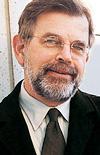Early Puberty and Early Exposure to Breast Cancer Risks: A Conversation with Robert Hiatt

Robert Hiatt
Breast cancer became more and more common during the last decades of the 20th century. Although the pace of new breast cancer diagnosis finally has reached a plateau, breast cancer remains the most often diagnosed cancer among US women. The mystery of high breast cancer rates is of intense interest to the public, as well as to the scientists who study population trends in this disease and who use this information to search for clues to its causes.
Known risks, such as reproductive and family history and normal aging, account for only a portion of new breast cancer. Some breast cancer activists and researchers are wondering whether a changing or deteriorating environment is partly to blame for the high incidence of the disease.
Marin and San Francisco counties in California have among the highest rates of breast cancer worldwide. Several years ago, local Marin advocates approached UCSF researchers about studying the problem. Their initial discussions sowed the seeds for a broader collaboration across the Bay Area and for what eventually evolved into the Bay Area Breast Cancer and the Environment Research Center, part of a network of centers with research participants from coast to coast.
Robert Hiatt, MD, PhD, deputy director of the UCSF Helen Diller Family Comprehensive Cancer Center, is the principal investigator for the network’s Bay Area center.
Preliminary studies of animals and of human populations suggested the possibility that early-life environmental exposures around the time of breast development might influence the risk of developing breast cancer later in life. Therefore, the research subjects in the centers’ studies are young girls, first observed at ages 7 and 8. Follow-up study will continue through puberty. The centers also use animal studies to investigate breast development and the evolution of cancer across the life span.
Among the suspected contributors to breast cancer risk is the changing US diet. We eat more, we eat differently and we weigh more than in decades past. Another suspect is exposure to man-made chemicals, such as certain estrogen-mimicking plastics. One finding from ongoing research at the centers is that girls are reaching puberty earlier than in past decades.
Alternative content
Related Links
- Discovering How Environment Contributes to Breast Cancer
- UCSF Today, Aug. 21, 2006
- Q & A with Robert Hiatt: Are Most Lung Cancer Deaths Among Long-Term Smokers Preventable with Affordable Screening?
- UCSF Today, Dec. 5, 2006